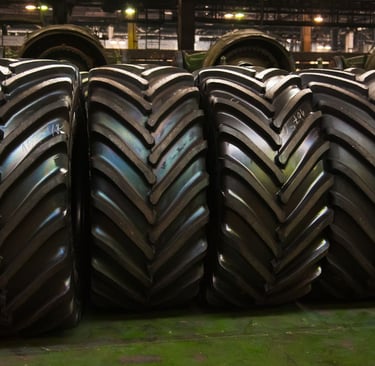The Practical Case for rCB in Tire Manufacturing: Beyond Sustainability to Performance and Profit
THE STORIES
TYROIL
7/16/20254 min read


For tire manufacturers, the pursuit of performance, cost-efficiency, and environmental responsibility is a constant balancing act. For decades, virgin carbon black (vCB) has been the undisputed champion, a critical reinforcing filler that gives tires their strength, durability, and black color. However, a new contender has emerged: recovered carbon black (rCB), derived from end-of-life tires through pyrolysis. While the environmental benefits of rCB are clear – diverting millions of tons of waste from landfills – the practical questions for manufacturers remain: Can rCB truly deliver on performance? What are the economic advantages? And how can it be seamlessly integrated into existing production lines?
This article aims to provide a practical overview for tire manufacturers considering the transition to rCB, moving beyond the sustainability narrative to address the tangible benefits and considerations for real-world application.
The Performance Equation: rCB vs. vCB
The primary concern for any tire manufacturer is performance. Tires must meet stringent safety, durability, and handling standards. Historically, rCB has faced challenges in matching the exact performance characteristics of vCB, primarily due to inherent impurities and structural differences resulting from the pyrolysis process. These can include residual ash, inorganic compounds, and variations in particle size and surface chemistry [1].
However, significant advancements in rCB production and upgrading technologies are rapidly closing this gap. Modern rCB suppliers are employing sophisticated purification and activation processes to enhance its quality, making it more consistent and closer in properties to vCB. While rCB may still exhibit slightly lower reinforcement properties compared to premium vCB grades, it can effectively replace a significant portion of vCB in various tire components without compromising overall performance. The key lies in understanding the specific rCB grade and optimizing the rubber compound formulation [2].
Practical Considerations for Performance:
Targeted Application: rCB is often best suited for specific tire components (e.g., inner liners, sidewalls, or certain tread compounds) where its properties can be optimized without impacting critical performance areas like wet grip or rolling resistance.
Blending Strategies: Manufacturers can achieve desired performance by blending rCB with vCB. Research indicates that rCB can replace anywhere from 10% to 100% of vCB, depending on the specific application and performance requirements [3].
Compound Optimization: Minor adjustments to rubber formulations, such as polymer ratios or additive packages, can compensate for any subtle differences in rCB properties, ensuring the final product meets specifications.
The Economic Advantage: A Clear Win
Beyond performance, the economic case for rCB is compelling. Recovered carbon black is generally less expensive than virgin carbon black. This cost differential can translate into significant savings for tire manufacturers, especially given the large volumes of carbon black consumed annually. The price stability of rCB, being less tied to volatile fossil fuel markets, also offers a strategic advantage in supply chain management [4].
Furthermore, the use of rCB can contribute to reduced operational costs through lower energy consumption in mixing processes, as some rCB grades may require less energy to disperse within the rubber matrix compared to certain vCB grades. This not only saves money but also aligns with broader energy efficiency goals.
The Environmental Imperative: Beyond Compliance
While performance and profit are key drivers, the environmental benefits of rCB are increasingly becoming a non-negotiable factor for tire manufacturers. Using rCB directly addresses several critical environmental challenges:
Waste Diversion: Millions of tons of end-of-life tires are generated globally each year. Incorporating rCB into new tires provides a robust, circular solution for this waste stream, reducing landfill burden and preventing uncontrolled burning.
Reduced Carbon Footprint: The production of rCB through pyrolysis typically has a significantly lower carbon footprint compared to the energy-intensive production of vCB from fossil fuels. By using rCB, tire manufacturers can substantially reduce their Scope 3 emissions (emissions from their supply chain), contributing to corporate sustainability goals and responding to consumer demand for greener products [5].
Resource Conservation: Replacing vCB with rCB conserves finite fossil resources, promoting a more sustainable and circular economy for the rubber industry.
Seamless Integration: Overcoming Processing Challenges
Integrating rCB into existing tire manufacturing processes requires careful consideration, but it is entirely feasible. The main challenges often revolve around the consistency and purity of rCB. However, reputable rCB suppliers are investing heavily in quality control and standardization to ensure their products meet industrial requirements.
Practical Steps for Integration:
Supplier Selection: Partner with rCB suppliers who can provide consistent quality, technical data, and support for formulation adjustments.
Pilot Testing: Conduct thorough pilot tests and small-scale production runs to fine-tune formulations and validate performance before full-scale implementation.
Process Adjustments: Minor adjustments to mixing parameters (e.g., mixing time, temperature) may be necessary to ensure optimal dispersion of rCB within the rubber compound.
The Future is Circular
The adoption of rCB is not just an environmental trend; it is a strategic imperative for tire manufacturers looking to enhance their sustainability profile, reduce costs, and maintain performance in a rapidly evolving market. By embracing rCB, manufacturers can transform a global waste problem into a valuable resource, demonstrating leadership in the circular economy and building a more resilient and profitable future, one tire at a time.
More Related Articles:
Bridging the Gap: TPO and rCB in the Global Supply Chain for Sustainable Manufacturing
The Quality Quest: Ensuring rCB Meets High Standards for Industry
The Silent Revolution: How rCB is Transforming Everyday Products (Beyond Tires)
The Unsung Heroes: Unveiling the Power of Pyrolysis By-products
References:
[1] ScienceDirect. (2021). Incorporating the recovered carbon black produced in an industrial.... Retrieved from https://www.sciencedirect.com/science/article/abs/pii/S0301479721003546
[2] ScienceDirect. (2025). Recovered carbon black: A comprehensive review of activation.... Retrieved from https://www.sciencedirect.com/science/article/pii/S2588913325000328
[3] Weibold. (n.d.). Weibold Academy: Recovered carbon black and its market potential. Retrieved from https://weibold.com/recovered-carbon-black-and-its-market-potential
[4] Verified Market Reports. (n.d.). Tire Recovered Carbon Black Market Size, Outlook, SWOT.... Retrieved from https://www.verifiedmarketreports.com/product/tire-recovered-carbon-black-market/
[5] Klean Industries. (2024). Building a Sustainable Tire Industry with Recovered Carbon Black.... Retrieved from https://kleanindustries.com/insights/market-analysis-
